|
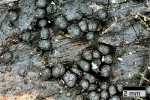
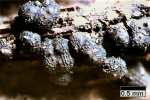
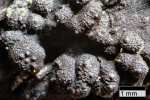
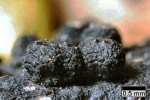
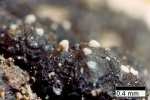
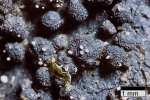
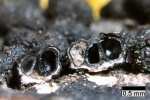
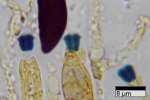
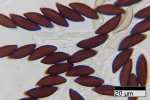
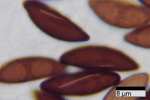
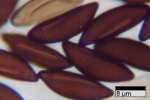
|
"Rosellinia" callosa G. Winter
Stromata scattered to densely gregarious on blackened host surface,
uniperitheciate, subglobose, 0.6-0.8 mm diam, to frequently multiperitheciate
containing up to 10 perithecia and then pulvinate, up to 1.5 mm diam, when young
greyish, later dark brown to black; surface deeply craked on sides and lower
part of the stroma; wall leathery; perithecia 0.5-0.6 mm diam enclosed in a white
to grey brown soft tissue tightly adherent to the wall, not disintegrating.
Subiculum absent.
Ostioles finely papillate, at the centre of a smooth flattened discoid
area.
Asci cylindrical, short-stipitate, with apical apparatus rectangular
with an apical rim, amyloid, 4-6 µm high x 4 µm broad.
Ascospores 19-27 (-28.5) x 6.5-7.5 µm, ellipsoid-inequilateral
with one end narrowly rounded to slightly pinched, the opposite one somewhat
truncate with a fugacious blunt cellular appendage, dark brown, with a sigmoid,
oblique germ slit 12-14 µm long on the flattened side.
Anamorph in nature occasionnally found emerging through the ostioles
of aged stromata, whitish to greenish grey; conidiophores arranged in palisades,
pale brown to grey, conidiogenous cells hyaline, conidia ellipsoid to tear-shaped,
6.5-10 x 3.5-4 µm, with fugacious crown-like appendage at apex.
Specimens examined. FRANCE,
Aričge (09):
Rimont, Las Muros, ruisseau de Peyrau, 23 Aug. 1997, JF-97127, on a stump of
Acer campestre;
Rimont, Las Muros, ruisseau de Peyrau, 28 Apr. 2001, JF-01082, on buried part
of a stump of Fraxinus excelsior; Rimont, Las Muros, ruisseau de Peyrau,
03 Dec. 2001, JF-01287, on wood of Alnus glutinosa;
Rimont, Las Muros, ruisseau de Peyrau, 8 Sept. 2002, JF-02159, on buried wood.
Notes: "Rosellinia" callosa, as stated by Petrini
(1993), is definetely not a Rosellinia, based on its lack of subiculum
and a marked tendency for being multiperitheciate. Moreover the stromatal wall
is not carbonaceous, and the white soft tissue surrounding the perithecia is adherent
to the wall and persistent. The combination of these features suggests
close affinities with members of the genus Xylaria with pulvinate
stromata tentatively placed in the genus Penzigia Sacc. (Petrini,
1993), but this name is not accepted for nomenclatorial reasons (Laessųe, 1989).
"Rosellinia" callosa is currently excluded from
the genus Rosellinia (Petrini, 1993), but keeps its name awaiting a better
placement.
Petrini (1993) reports she cultured a fresh specimenof R. callosa,
but the cuture failed to produce an anamorph. We had the opportunity to find
an anamorph growing on old stromata which is much like the anamorphs usually
encountered in Xylaria. Interestingly, in this specimen, the conidia
exhibit faint crown-like appendages at apex, a feature described in two tropical
species of Xylaria, X. allantoidea (Ber.) Fr. and X. laevis
Lloyd (Ju & Rogers, 1999). This observation, if it was done again in
culture, would be an additional support to the further placement of this fungus
in Xylaria.
"Rosellinia" callosa is easily overlooked as it grows
almost exclusively on buried wood, usually the base of stumps of shrubs, just
under the soil level. It is reported by Petrini (1993) on Alnus and Populus,
and was encountered during this study on wood of Acer campestre, Alnus
glutinosa, Evonymus europaeus, Fraxinus excelsior and Lonicera nigra.
It is known from Europe (Fürstentum Lichtenstein, Great Britain, Switzerland)
(Petrini, 1993). Our reports are likely to be the first published ones from
France.
|